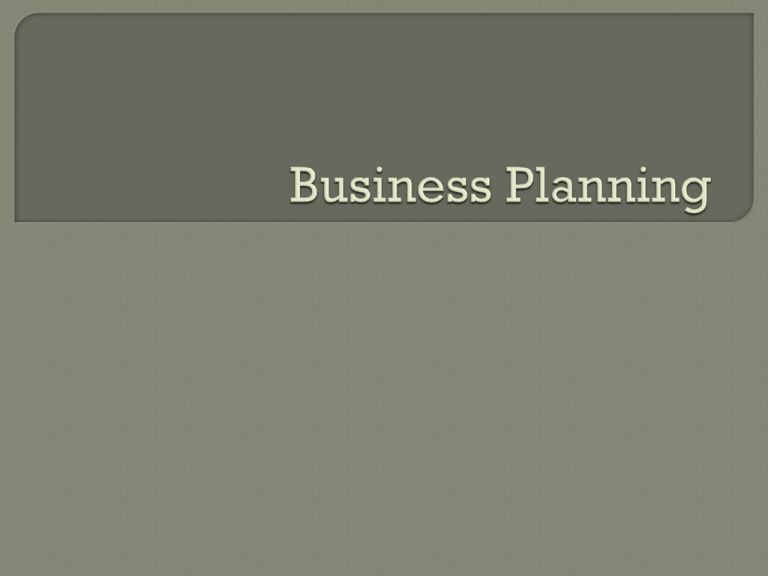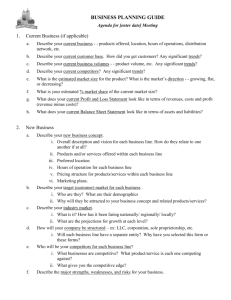Business Planning
advertisement

A detailed guide to establishing a new business or entrepreneurial venture within an existing agency 1. 2. 3. 4. 5. 6. 7. 8. 9. Executive Summary Business concept Products & services description Target Market Competitive analysis Marketing plan Operations & management plan Development plan Financial statements Introduction/Business Plan Goals • Introduce the entire plan first • Goals: Investment Board/staff support Additional programs/services Expanded offerings Basic details @ business • Name, location, contact • DBA – doing business as • Agency description Legal status • How is business formed (ie. Sole proprietorship) • Licensing & distribution agreements • Trademarks, copyrights, patents Company history, development stages • History of the agency Virginia Theatre • Values, vision, mission Company history, development stages • Phase of business development Seed company – Basic business concept developed but it has not been launched and no sales have been made. Start-up –Early stages of operation, just begun to sell products Expanding – Rapid growth business that wants to increase its product offerings. Stable –Currently in operation with consistent sales & modest growth. Retrenchment –Little or no growth in sales; needs changes to its product line or organizational structure to attempt to boost sales. Company history, development stages • What has been accomplished to date Secure location Develop prototype Investors Market research Industry analysis • What the industry is • What state the industry is in North American Industry Classification System (NAICS) • What changes, trends & growths it is facing • SWOT analysis…. • PEST analysis…. Internal External Negatives Positives Strengths Weaknesses internal capabilities, attributes and resources that help the agency to reach its objectives and/or to create a competitive advantage internal limitations that impeded the agency from reaching its objectives and/or creating a competitive advantage Opportunities Threats external factors that the company may be able to take advantage of in order to grow, increase profits, or enhance effectiveness Changes in the external environment that have the potential to impede the agency’s performance Strengths •Access to national forest land •Trail system •Outdoor recreation •Scenic Views Opportunities •Government grants •Partnerships Weaknesses •No community parks •No community recreation center •Not enough summer destination activities for visitors •Stewardship of our open space •Trails lack connectivity (regional and local) •User conflicts on existing recreational facilities Threats •Environmental Strengths Weaknesses Opportunities S-O Strategies: Pursue opportunities that maximize the agency’s strengths W-O Strategies: Overcome weaknesses in order to take advantage of opportunities Threats S-T Strategies: Determine ways to use agency strengths to minimize threats W-T Strategies: Implement strategies that prevent agency weaknesses from being highly susceptible to external threats Political, Economic, Socio-Cultural, Technology Focus on threats Political: * Tax laws & policies * Labor laws * Government regulations * Environmental regulations * Government intervention Socio-Cultural: * Population growth & changes * Social issues * Population health & education *Employment patterns * Community lifestyle Economic: * Economic growth & stability * Inflation * Exchange rates * Minimum wage changes * Interest rates * Unemployment rates Technology: *Technology advancements * Technology changes * Automation * Research & development 1. 2. 3. 4. 5. Detailed product description Detailed facilities description Potential suppliers Profit centers Partnerships Detailed product description • Crystal Lake Boathouse & concessions Open Memorial to Labor day Boat rentals, concessions, fishing Space for small rentals • Qualities & benefit to fill niche Good product will fill a gap in the market Detailed facilities description • What you have • What you want • Location • Amenities • Strengths & weaknesses Potential suppliers • Directly from manufacturers Best info about products Solid customer service • Manufacturer’s representative Ie. Reps for Columbia, Patagonia, North Face Come to your business to demo products Buy in brand bulk Potential suppliers • Distributors (wholesalers) Buy products from many manufacturers Warehouse it & resell at wholesale prices • Trade Shows Large selection of manufacturers Order equipment for a year • Internet Potential suppliers…what • Minimum quantity to ask • Quantity discounts • Payment terms Net 30 pay in full in 30 days 2-10 net 30 2% discount if paid in 10 days or full amount due in 30 days • Payment dating Delay payment to give more time to sell items Potential suppliers…what to ask • Pre-season discounts • Closeout items • Shipping date Est. a shipping date & cancel after that date Profit Centers • Parts of the business that will generate revenue • Determine if it adds value & their is demand • Rentals Pros & cons?? Profit Centers • Small scale manufacturing Make own equipment Most common w/ outdoor outfitters • Food & beverage Permits & licenses Partnerships, AKA… • Agreements • Cooperative ventures • Joint arrangements • Alliances • Collaborations • Interagency Cooperation A relationship between two or more parties for the purposes of addressing a common challenge Constitution Trail • NPRD, BPRD, Friends of Constitution Trail Naperville Ribfest • NPD, City, Naperville Exchange Club Provena St. Joseph Inwood Athletic Club • Joliet Park District, Provena St. Joseph Medical Center Strong target market • Definable Identify specific characteristics of potential customers • Meaningful Characteristics directly relate to purchasing decisions Strong target market • Sizable #’s large enough to sustain business • Reachable Effectively market to them ($$$) Geography • City, county, region • Type of areas – urban, rural, suburban • Travel distance Demographics Purchasing patterns • Who makes purchasing decisions? • How often do they buy? • Advanced purchases? • Concerns of customers (price, quality, convenience) Market size • Use demographic variables & characteristics • Other factors that influence Market trends • Growing/shrinking population • Competitors • Economy Competition faced • If you have a market, you have competition • Direct Offers products much like yours that customers perceive as acceptable alternatives McDonald’s vs Burger King Hyatt vs Hilton • Indirect Offers products different from yours that meet the same or similar need Customers can substitute your competitors’ offerings for yours Children’s Discovery Museum vs Chuck E. Cheese Train vs air travel Competition faced • Develop strengths & weaknesses list for competitors • What attributes do they have that would inhibit you from competing? Well known brand Continued growth Longevity Name recognition Competition faced • Examine customer perception factors What customers can see What attributes make competition attractive to the customer Price, quality, service, social consciousness, reputation • Examine internal operational factors What customers can’t see Factors that put your customer at a stronger or weaker position Labor costs, marketing budget, expertise, location, access to suppliers, partnerships Competition faced…Dick’s Sporting Goods What specific businesses do you consider to be your direct competition? Fill in the information requested for each. Competitor Strengths Weaknesses Other Attributes Wildcountry Outdoor expertise; Customer service; Limited product lines; Caters to more serious outdoors people; limited advertising budget; classes draw potential customers Market share distribution • Market share = agency’s sales/total market sales • Sources of information Trade associations Annual reports Business publications Independent research firms IBIS World database… Competitive position • Rank order competition based on market share, strengths, weaknesses • Demonstrates understanding of strength of competition Rank competitors from strongest to weakest citing reasons for each ranking. Rank Competitor Reason for Ranking 1 Wildcountry Outdoor product niche; strong expertise 2 MC Sports Similar product line; large market share Competitive edge • Concrete examples • Show how competition’s weaknesses are your strength • Examples: Price Product features Convenience Marketing Well known brand Operational efficiencies Barriers to entry into the market • Patents & trademarks • High start up costs • Hard to find technical or industry expertise • Market saturation • Restrictive licensing requirements • See what IBIS World says





